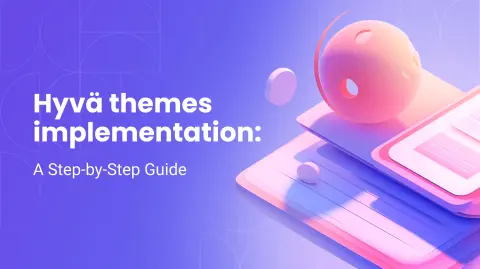0%

Developing a perfect online store is a journey filled with challenges and potential pitfalls. Not all challenges are created equal; some may not be critical, while others can have a significant impact, costing a fortune for your budget. Being proactive and adopting a strategic approach helps businesses ensure a smoother development process.
In this article, we will explore five common pitfalls in e-commerce development and provide actionable solutions. Among them are:
- Skipping the project roadmap
- Ignoring the importance of user journey
- Misconceptions in building an MVP
- Budget vs. Project Requirements:
- High team turnovers and skills mismatch
1. Skipping the Project Roadmap
Imagine gearing up for a road trip without a map or a clear destination — sounds chaotic, right? That's the risk of diving into e-commerce development without a comprehensive project plan. To prepare a roadmap for your store, consider taking the following steps:
1. Clear project objectives:
Define your project's objectives with clarity. Clearly set the goals and outcomes you aim to achieve with your online store. This sets the foundation for a focused and purpose-driven development process.
2. Milestone identification:
Identify key milestones in your development journey. Breaking down the project into significant achievements allows for better tracking, evaluation, and celebration of progress at different stages.
3. Stakeholder involvement:
Involve key stakeholders when planning the project. Collaborate with business owners, marketing teams, and other relevant parties to gather insights and align project objectives with broader business goals. This ensures that the roadmap reflects a holistic understanding of the business needs and customer expectations.
4. Realistic timelines:
Set realistic timelines for each phase of development. Consider the complexity of tasks, resource availability, and external dependencies. Realistic timelines prevent undue pressure and contribute to a more sustainable development process.
5. Risk analysis:
Conduct a comprehensive risk analysis to identify potential challenges and uncertainties. Anticipating risks allows for proactive mitigation strategies, minimizing the impact of unforeseen obstacles on the project timeline and objectives.
By incorporating these additional steps into the process of creating a project roadmap, you are building the foundation of your online store.
2. Ignoring the Importance of User Journey
Creating a successful online store depends on delivering a smooth user experience. It’s essential to understand your customers' behavior and needs throughout their shopping journey, to achieve this. However, during the development stage, envisioning these user journeys can be challenging, potentially impacting the effectiveness of your online store.
This is where tools like wireframing come into play. Wireframing focuses on structuring key elements such as navigation, content areas, and calls-to-action. By providing a clear roadmap for design and development, wireframing proves to be instrumental in saving time, costs, and mitigating potential issues during later stages of e-commerce website creation.
Beyond wireframing, there are various other tools that can help in creating and testing user journeys. Prototyping tools are used to simulate user interactions and refine the user experience before final development. User flow diagrams, crafted using platforms, provide insights into user navigation paths, aiding in the optimization of the overall interface.
Mockup tools enable the creation of detailed design representations, offering a more granular exploration of visual elements. Usability testing tools provide valuable feedback by observing real user interactions, identifying potential issues for improvement. Style guide tools ensure design consistency by documenting visual elements and brand guidelines.
Additionally, user persona tools assist in creating detailed user profiles based on research and data. All combined, by strategically combining these tools throughout the development process, you can effectively create the user journey for your site.
3. Misconceptions in Building an MVP
When developing a Minimum Viable Product (MVP) for your online store, a common pitfall is attempting to cram all desired functionalities into it. This can lead to a bloated and delayed development process, increased costs, and potential conflicts within the e-commerce team and/or the agency. Here's your go-to approach to avoid MVP-related pitfalls:
1. Revenue-generating features first:
Prioritize features directly linked to revenue. Identify core functionalities aligned with primary goals, ensuring the initial release delivers tangible user value.
2. Phased implementation:
Opt for a phased approach instead of cramming all desired functionalities into the MVP. Start with essential features, allowing for a quicker launch and creating room for future enhancements.
3. Set realistic expectations:
To ensure a collaborative development environment, set realistic expectations. Clearly define the MVP's scope to manage conflicts within the team and/or with external agencies.
4. Iterative development:
Embrace an iterative process, refining the MVP based on user feedback and evolving requirements. This ensures the online store adapts organically to user needs and market dynamics.
Successfully addressing these MVP misconceptions not only ensures a successful online store launch but also lays the foundation for sustained long-term growth.
4. Budget vs. Project Requirements:
Online store development requires careful consideration of budget and project requirements. However, businesses often underestimate this crucial aspect. Consider the following strategies to navigate budgeting effectively:
1. Phased project breakdown:
Break down the entire project into manageable phases. For each phase, estimate costs and allocate resources. This approach allows for a more granular understanding of financial needs at different stages of development.
2. Utilize budget tracking features:
Leverage budget tracking features available in project management tools. These features provide real-time insights into expenditure, enabling businesses to make informed decisions about resource allocation and cost management.
3. Thorough briefings and documentation:
Don't underestimate the power of detailed briefings and documentation. Clearly document project requirements and objectives, ensuring that all team members share a comprehensive understanding. Thorough documentation serves as a reference point and minimizes misunderstandings.
4. Open communication:
Implement communication tools that foster transparent and open dialogue within the team. Regular meetings and updates contribute to a shared understanding of the project's progress, allowing for timely adjustments and preventing potential issues.
By incorporating these tools and practices into the process of development, businesses can mitigate risks related to misaligned budgets and project requirements.
5. High Team Turnovers and Skills Mismatch
Another common pitfall arises from issues within the development team, regardless of whether you work with an agency or have an in-house team.
Having a stable and professional project team is essential for the successful development of your online store. High turnover in your team introduces risks to your workflow. While some turnover is natural, fostering a positive work environment and providing competitive compensation can significantly help retain valuable developers.
Another significant hurdle is the potential skills mismatch within the development team, presenting various manifestations such as a lack of proficiency in crucial technologies, communication gaps, or struggles to adapt to evolving project requirements.
It's crucial to have developers with e-commerce experience on your team, as each store requires a specific tech stack. Assuming that mastering just one e-commerce platform is enough to build a top-performing store is a mistake.
For sure, hiring the best experts might exceed your budget, especially when starting a business. Juniors can handle the task well, but it's crucial not to rely solely on interns. When planning hires, consider needed competencies, balance juniors and seniors in your team, and ensure a qualified manager of the project.
Conclusion:
We've discussed common e-commerce development pitfalls, including planning, design, budgeting, and misconceptions about MVPs. To overcome these challenges, businesses need to adopt a proactive and collaborative approach, whether they work with an agency or have an in-house development team.
By making smart choices and paying attention to users' experience, businesses can improve the chances of starting and keeping a successful online store in the competitive e-commerce world. For expert assistance in navigating these challenges, contact Transform Agency today!
Expert in ecommerce website development topics. Skilled SEO Specialist with a proven track record of improving website visibility and search engine rankings. Experienced in keyword research, on-page and off-page optimization, link building, and content strategy development. Passionate about staying updated with the latest SEO trends and algorithm changes to ensure optimal online presence.
Experienced SEO Specialist with a proven track record of improving website visibility and search engine rankings. Skilled in keyword research, on-page and off-page optimization, link building, and content strategy development. Passionate about staying updated with the latest SEO trends and algorithm changes to ensure optimal online presence.


